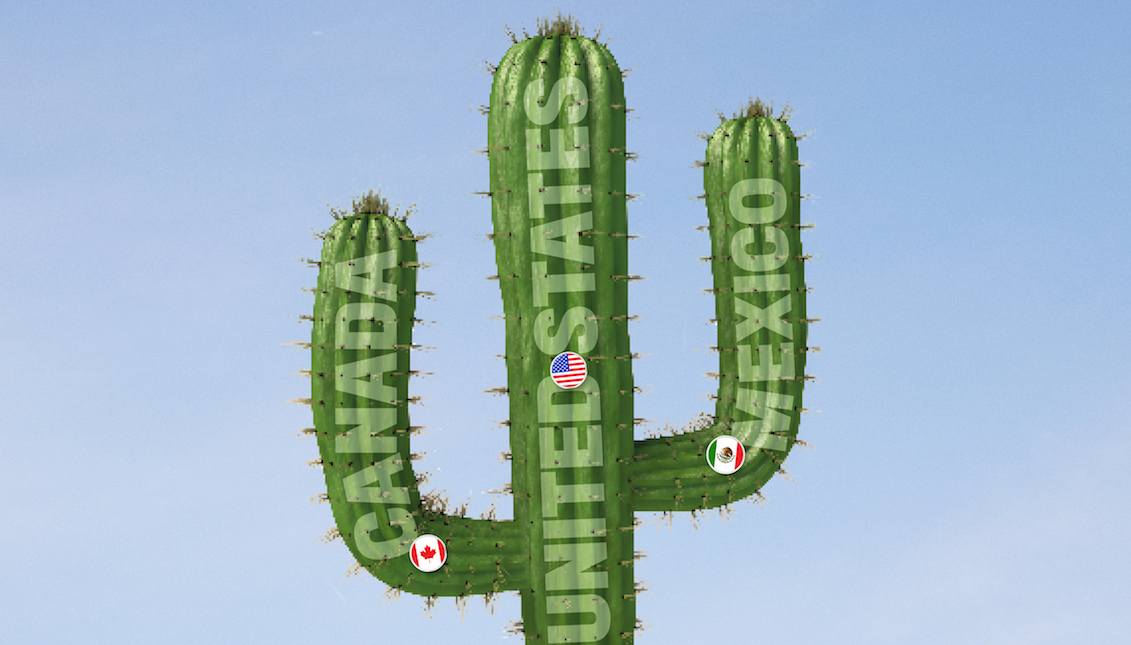
NAFTA, a "thorny" agreement
A historical and economic perspective on the engines that drive the Latino to cross the border.
When we refer to immigrants within the United States, there are many postures and collective worldviews that arise around the millions of people who decide to cross a border – either by land, sea or air - and start from scratch in an unknown country.
According to data from the Pew Research Center, the immigrant population in the United States currently has 43,158,110 individuals, of which 11,576,253 (or 26.8%) come from Mexico. Similarly, of the 690,000 young people who arrived in the country as children (called Dreamers), 548,000 (that is, 79.4%) are of Mexican origin.
Although the most logical reasons behind these figures imply the territorial proximity between both countries and the historical border links between both communities (such as the events following the Mexican Revolution of 1910 and the Second World War), there is a fundamental economic framework inherent to the migratory engine and whose responsibility falls on both countries.
AL DÍA has talked with two specialists on the subject to try to expose the nature of the neoliberal economic strategies that have changed the destiny of millions of immigrants.
Although this history goes back more than a century, between 1900 and 1910 more than a million Mexicans decided to cross the border into the United States, fleeing especially from the destruction of the Mexican Revolution and in search of a fertile land where they could find work.
But if on one side there was a willingness to work, on the other there was a need for workers.
It was during the great world conflicts, at the beginning of the century, that thousands of Mexican workers recovered the fields and factories abandoned by the Americans who had left for battle. This is how the Temporary Workers Program came into being, better known as the First Bracero Program, which consisted in the transfer by the US government of a thousand experienced Mexican farmers to grow and harvest sugar fields in the Stockton region of California, and later in other regions.
This program was concluded bilaterally in 1964 when both governments were attacked by allegations of human rights violations suffered by workers in the hands of their employers.
Faced with the reluctance of many peasants to return to their country, a first Border Patrol was born, radically changing the migratory quality of the peasants who were now persecuted and expelled.
But the door was open, and since then the migratory flow has been a constant between both countries; the only thing that has changed, as Horacio Mercado Vargas and Marisol Palmerín Cerna remember in Causes and Consequences of the Migration of Mexicans to the United States of America (2009), is that Mexican braceros are now called "illegal".
According to the data of the National Population Council of Mexico (CONAPO), the migratory flows from Mexico to the United States are profoundly heterogeneous, varying in origin, motive, transfer, and strategy, especially after the decade of the 70s.
According to Selene Gaspar Olvera of the Academic Unit in Development Studies (Zacatecas), in 1970 there were about 900 thousand Mexicans living in the United States, a figure that will increase exponentially to little more than 2 million during the 1980s, when Mexico would become "one of the main emigrant dispatcher" to the United States.
But it was the simultaneity of economic crises that both countries experienced during the 1990s, which would keep the rate of immigration constant and to gradually increase.
In the early 1990s, the United States and Canada already had a bilateral Free Trade Agreement that was promoted as "a way of sustained economic growth," as recalled by José Luis Calva, a researcher at the Macroeconomic Analysis Center of the UNAM, known like the North American Free Trade Agreement (NAFTA). In the middle of a crippling crisis, Mexico decided to get involved, signing its part of the agreement on December 17, 1992.
Ram Mudambi, Professor of Strategy and researcher at the Fox School of Business and Management at Temple University spoke with AL DÍA about the economic implications of this type of multilateral agreements in the immigrant population in the United States.
"NAFTA is an agreement that is almost 25 years old now, and it was a very clear agreement, which was signed to increase the economic permeability of the three member states, and started as an agreement between Canada and the United States that allowed the first to maintain competition, especially in the automotive market, "explains Mudambi.
What did the NAFTA effect mean in the economic development of the three countries? Could that affect the economic development of smaller countries like Mexico?
In fact, NAFTA has been a huge success in several aspects. One of the fundamental reasons is that economic opportunities in Central American countries are more limited. What happened with NAFTA, especially with the Maquiladora Program, is that Mexico has developed a lot of new companies that have created many jobs. This does not imply that the migratory pressure does not exist because it is still there, but I can say that without NAFTA, the migratory pressure towards the United States would be much higher.
What would it mean if President Trump decides to withdraw from NAFTA?
I'm a business professor (laughs). It's a populist approach, but the data is very clear. Growth rates in the United States, Canada, and Mexico have varied. Before the NAFTA was signed, in 1993, the United States GDP was 6.9 billion; in 2016 it was 18.5 billion (an increase of 170%). In Mexico, the GDP in 1993 was half a trillion dollars, in 2016 it was 1.06 trillion (an increase of 112%). The United States, in fact, has earned more than Mexico thanks to NAFTA. If the United States withdrew, the effects would revert to the country's economy, and Mexico would lose more than us. There are many companies working in Mexico, and if the agreement is canceled, their costs would increase considerably, and the plants should be relocated, perhaps, in Asia. All would lose, but the effect in Mexico would be important, increasing the migratory pressure.
What do you think of the position of many against NAFTA for alleged negative effects on the Mexican economy?
First of all, NAFTA involves only Mexico; therefore, the rest of Central America is not affected. As for Mexico, there has been a change in ownership patterns. For example, if you try to buy tomatoes in the United States during the winter, the vast majority of them say "made in Mexico"; is Mexican agriculture. And that is true. But most of the products that reach the US market come from crops that are owned by the United States in Mexico. Large corporate crops have gone to Mexico and own an immense amount of arable land in Mexico, using Mexican land to supply US consumption. Although the problem tends to be more political (due to the change of ownership), if you are a Mexican worker, it is better for you to work in a US company than in a Mexican company because the salaries are higher and your working conditions are better. The effect is similar to what is perceived in the United States or Canada with small businesses because corporations are more efficient.
Based on the specific data of economic research, the outlook seems promising for the Mexican population, but we cannot avoid reflecting on the immigration rates and the economic circumstances that are behind the migratory movements, whose current political epicenter are the young undocumented immigrants called Dreamers.
For this, we have turned to the professional opinion of José Sánchez, Professor of Political Science at Long Island University, and author of the book Boricua Power: A Political History of Puerto Ricans in the United States.
RELATED CONTENT
What is your opinion regarding the current status of the DACA program?
I think the political leadership has failed. They don’t have the language to explain to the American public about not only immigration but what it means to be part of this global economy. They don’t understand. They don’t know how to explain it and they don’t know how to lead, they just keep kicking the can down the road.
Do you think that this anti-immigrant turn in political rhetoric was predictable? Is this a historical phenomenon?
For me, immigration is, like many other aspects of the global system, an issue that has its positives and negatives. Immigrants have helped build this country in the past and continue to do so. When you go to restaurants and look at the kitchens, it's basically Latinos who are working there. They are there because this economy could not survive unless people have access to that kind of service, and to make it affordable they have to reduce the cost of producing goods, and that is what immigrants do. These are the positive aspects of immigration that people do not recognize because the only thing they see is the negative: the fact that people come without speaking the language and that they look different.
In your column for the National Institute of Latino Policy, you claim: "DACA supporters are making a mistake in suggesting that supporting these young people is a form of moral test." What do you mean?
The majority of the population wants to see Dreamers get some kind of legal status, but that is not what drives the policy because that is not the center. The extremists are the ones Trump wants to keep because he knows that these are the people who can maintain the passion he believes he needs to be reelected.
Many of those who campaign for the Dreamers say "Oh! Look at these guys, so young, so innocent, etc." This is not what the United States wants to hear because the American is also suffering. So, Trump is addressing this suffering to turn it against immigrants, trying to stop immigration; making them think that their problems are in some way connected to the fact that these immigrants are in this country, both Dreamers and documented. And that is not the case. The problem they face is due to the globalized economy, the capitalist economy, and the companies that are making decisions independently of the immigrant, but based on short-term profits.
The connection we must make is between the conditions of the American middle and working class and the situation suffered by people in other countries who feel the need to come for political or economic reasons. It can not be done separately because these Americans do not really know much about other parts of the world, but it is the leaders who have to clarify it, especially the progressives, those who think they are presenting a different message.
Trump did something similar when he said "Americans are Dreamers, too," and we should do that. Let's do it, call the American worker Dreamer and say, "they had a dream that was shattered in the last 30 or 40 years", in the same way, that the dreams of these young people have been destroyed by circumstances beyond their control. Let's make that connection so that people stop seeing immigrants as the enemy and see them as potential partners.
"I think the political leadership has failed. They don’t have the language to explain to the American public about not only immigration but what it means to be part of this global economy."
What effect has NAFTA had on immigration in the United States?
People do not understand this but Mexicans started coming here because - and this started before NAFTA, but the agreement pushed it - US companies wanted to sell their products there, including the same kind of products that Mexicans were growing like corn. Because, while it is true that companies can produce corn here much cheaper because of all the chemical and crop advantages, they still displaced Mexican corn production. The crops had to be sold and production started there as well (since US companies started buying land). What happened was that many farmers were left with no other option than to try to move to the cities - such as Mexico City or Guadalajara - in search of work, but they did not succeed because the Mexican economy was not so developed (and it is not yet), so the last resort was to go where they could get work and that place was the United States.
There are those who think that this is another conspiracy theory.
This has also happened in other US territories such as Puerto Rico, where similar processes have been seen. When Puerto Rico was absorbed by the United States, the government became involved in a series of policies and laws that caused tremendous damage to the island, unleashing a large migration of Puerto Ricans to the continent, but also affected its development. For example, a law was passed in 1920, the so-called Jones Act, which required that any good that was sent from any country to Puerto Rico should first land in US territory before going to Puerto Rico. This made everything consumed in Puerto Rico become extremely expensive.
These are the things that are part of the legal system, they are not simply conspiracy theories; these are things you can look up (in books). Some leaders of Congress talked about eliminating this to help Puerto Rico recover but there is too much interest invested to keep this up, even though the law was initially approved to protect the merchant marine during world conflicts. Everyone knows the effects this has had on the Puerto Rican economy, and nobody cares.











LEAVE A COMMENT: